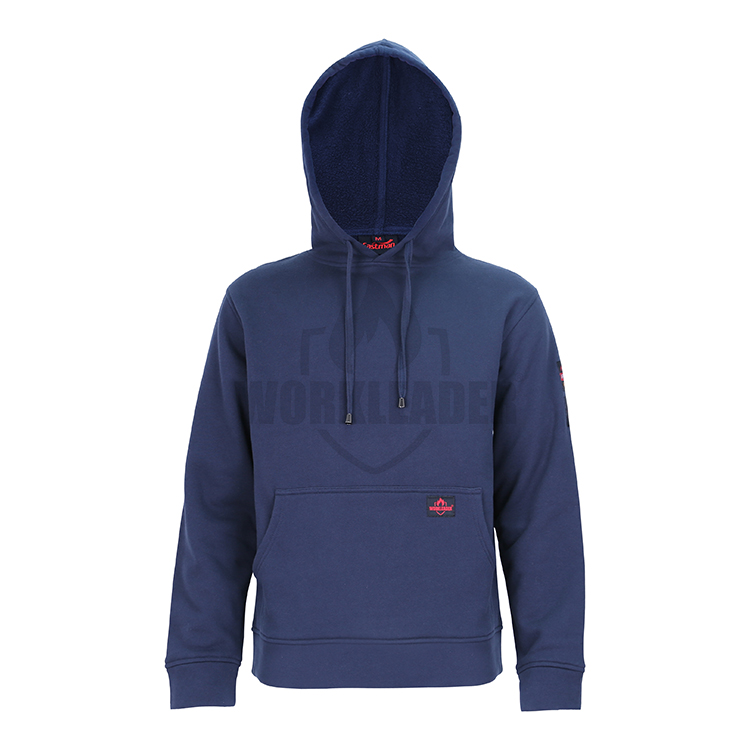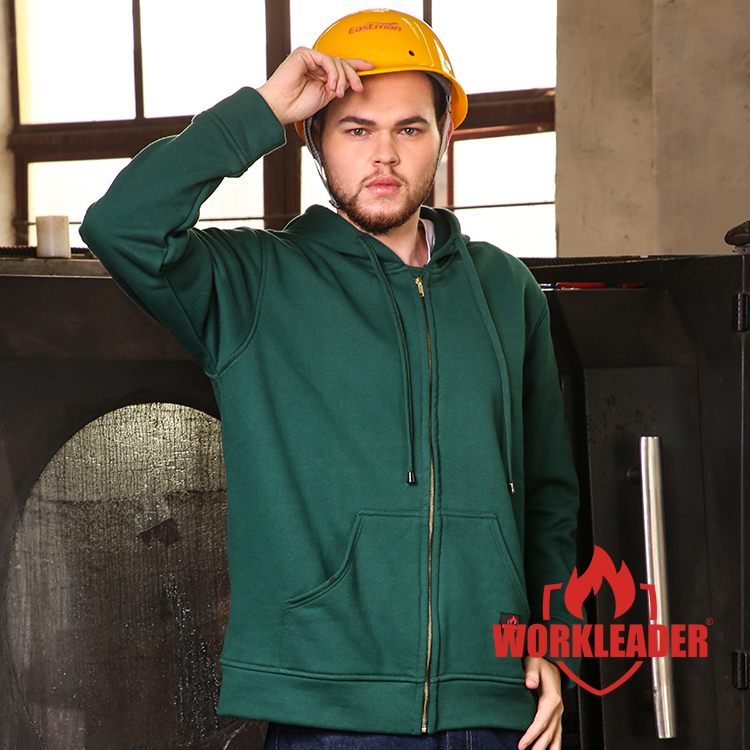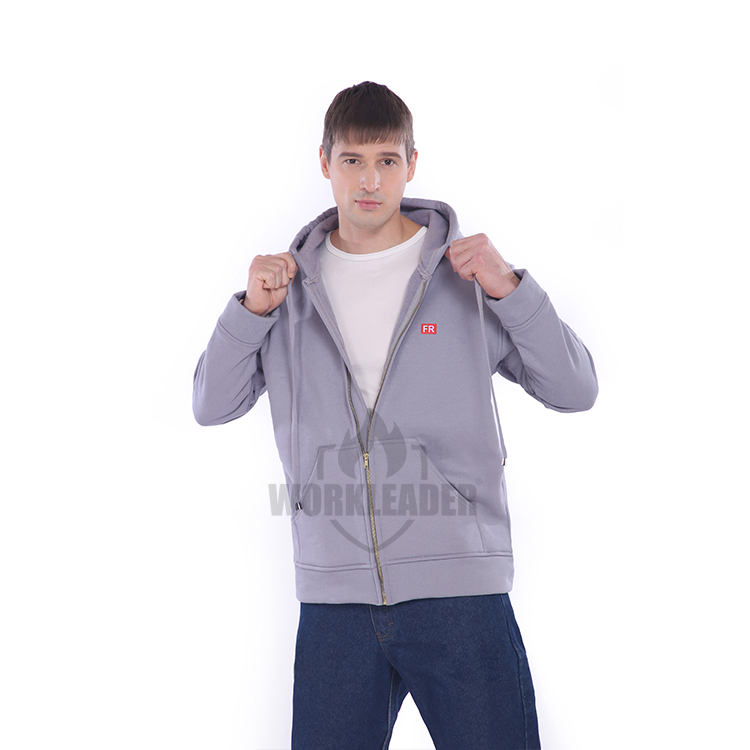Categories
Product Recommended

Flame Resistant Fleece Hoodie Suit

Knit 100% Catton Fire Retardant Hood

Flame Retardant Hoodies For Worker
FR Jeans
What Is Fr Jeans
FR jeans are designed with thermal properties that prevent burning, limiting the amount of heat transferred to the skin. Since they lower the risk that the clothing will catch fire, FR jeans are a much safer form of workwear. Many FR jeans are also arc-rated, meaning they can prevent third-degree burns and high-voltage currents. FR clothing rated for workplace safety is much better than regular jeans, especially in high-risk environments.
Benefits Of FR Jeans
- Benefits Of FR Jeans
- Manufacturers design FR jeans to withstand extreme conditions, making it significantly more durable than standard workwear. The materials and fabrics used in FR jeans can resist tears, abrasions, and holes. This enhanced durability means that it's also a cost-effective solution.
- Improved worker visibility
- Many FR jeans options include high-visibility features or are compatible with high-visibility vests. This compatibility is especially beneficial in low-light environments where visibility is critical to prevent accidents.
- Chemical resistance
- Some types of FR jeans offer protection against chemicals in addition to flame resistance. This addition is particularly advantageous for workers in the chemical manufacturing, handling, and processing sectors.
- Comfort and compliance
- Have made significant advancements in the design and material composition of FR jeans, focusing on wearer comfort without compromising safety. Modern FR garments consist of breathable fabrics that manage moisture and regulate temperature, making them comfortable to wear for extended periods.
- Psychological ease and productivity/dt>
- Wearing FR jeans can impart a sense of security for workers, knowing that they're safe against unforeseen accidents. Workers' job satisfaction and productivity can increase when they feel safe on the job, contributing positively to the overall efficiency and morale of the workforce.
Why Choose Us
-
01/
Professional team and equipmentWith more than 30 years of production experience, we have a mature team and equipment. From fabrics to garments, we use smart machines. We are efficient and cost-effective.
-
02/
MarketOur garments have been exported to many countries and regions in the world, such as Europe, North America, South America, Middle East, etc. We export 150 X 40 FCL every year.
-
03/
Provide the best quality productsWe provide the highest quality fibers, fabrics and finishes to create the most comfortable, durable and ultimate protective PPE and FR clothing.
-
04/
Our serviceYour satisfaction is always our top priority. If you need real-time assistance, please feel free to contact us through our customer service hotline 0371-86173598.
The Differences Between Fr Jeans And Regular Jeans
The most significant difference between regular and FR jeans is the materials they're made of. Regular jeans are made of cotton, which is combustible. The fabric can melt to the wearer's skin, causing excess injuries when exposed to high temperatures. FR jeans are designed to resist flames and self-extinguish. In the event of an accident, this feature can mean the difference between minor injuries and catastrophic consequences. That's why it is required that male and female employees wear equipment such as FR jeans in workplaces where there is a risk of heat or flames.
How Long Can FR Jeans Resist Fire?
How long the FR jeans protects the wearer from continual exposure to fire depends on the level of protection provided. These hazard risk categories are ranked from Category 1 to Category 4. The higher the category, the more protection is offered for a longer period of time. In most cases, low-hazard tasks require only a Category 1- or Category 2-level of protection.
How To Know When It's Time To Replace An FR Jeans
-
Thin Patches Or Worn Areas
If the fabric is worn out, there are abrasions to the fabric or there are any areas where you can see the fabric, the jeans integrity has been compromised, and it's time to discard it.
-
Rips Or Tears
Similarly, rips or holes in the fabric mean that it is no longer able to protect the wearer's skin from flames and thermal injury. Any flames will go directly to the skin because there is no barrier.
-
Significant Alterations
If the fabric is cut and resewn aggressively, it may no longer be serviceable as protection, especially in the areas of the new seams.
-
Misshapen Jeans
If the fabric is old enough to become baggy or it no longer fits the wearer the way it should, it may not be protective and should be replaced.
-
Bleach Contact
If any part of the jeans comes into contact with bleach on the job or in the process of being cleaned, it's time to replace it.
-
Irreparably Dirty
If the jeans has been cleaned but still smells like chemicals, has greasy stains or is otherwise no longer serviceable, a new jeans is needed.
How To Tell Whether FR Jeans Are FR?
he vertical flame test
In the vertical flame Test, a fabric sample is exposed to a flame for a specified period and then observed. The key metrics include:
After-Flame Time: The duration for which the fabric continues to burn after the flame source is removed.
After-Glow Time: The time the fabric glows after the flame is extinguished.
Char Length: The length of the damaged area, indicating the fabric's resistance to flame spread.
Heat transfer performance test
This test evaluates how much heat penetrates the jeans under high-temperature exposure. It's essential for understanding the protective capabilities of FR jeans against prolonged heat and fire exposure.
Arc Flash Testing: Measures the jeans ability to protect against electrical arc flash hazards.
Flash Fire Testing: Simulates sudden, intense fire exposures to assess how well the jeans protects the wearer.
Advanced thermal mannequin testing
The advanced thermal mannequin test, or the so-called Thermoman Test, a sophisticated method, offers a realistic assessment of FR jeans. It simulates real-life fire exposure scenarios to evaluate the jeans overall protective performance. Sensors on the mannequin measure burn injuries, providing crucial data on the effectiveness of the FR jeans.
What Should You Consider When Choosing FR Jeans
Material matters
The composition of your FR jeans makes a huge difference in their overall protective properties. Various materials offer fire resistance, including treated cotton, Nomex, and modacrylic, each with different levels of protection, durability, and comfort. To find a quality pair of FR work jeans, look for fabrics that are guaranteed to provide protection for the lifetime of the garments.
Fit and comfort
While safety is paramount, fit and comfort come in as close seconds. Jeans that are too tight may inhibit movement and can compromise the protective layer of air between your skin and the garment. Conversely, pants that are too loose can catch on machinery or tools. Look for an ideal fit that provides safety and comfort throughout your workday.
Durability and longevity
Investing in high-quality FR jeans saves you money in the long run. Inspect the craftsmanship and sturdiness of the jeans. Reinforced seams, heavy-duty zippers, and durable fabric contribute to the longevity of the pants. Be sure to follow the laundering instructions carefully to maintain their protective properties.
Compliance standards
Reputable FR jeans should adhere to safety standards set by organizations such as NFPA or ASTM. These standards ensure that the jeans have undergone rigorous testing to guarantee their protective abilities. Look for labels on your FR jeans, verifying compliance with these standards to ensure your clothing has adequate protection against common workplace hazards.
Materials Used To Make FR Jeans
-
01/
NYLON:Nylon fabric has a high melting point and resistance to heat. They possess high tensile strength.
-
02/
FR cotton:Special type of treated cotton has a high melting point. They are specially blended with nylon.
-
03/
PBI:Polybenzimidazole or PBI fibers show high resistivity to extreme thermal exposures. It also has strong durability and is comfortable to wear.
-
04/
ARAMIDS:Aramids are those synthetic fibers which have high heat resistivity, resistance to organic solvents, chemicals and abrasions and high tensile strength.
-
05/
MODACRYLIC: Modacrylic is copolymer having high resistivity to heat and high resilience.
-
06/
NOMEX:Nomex is a meta-aramid fabric. It has radiation resistance.
Application Of FR Jeans
Oil and gas industry
In the oil and gas industry the most common issue that workers face is the risk due to flammable gases and liquids. When you are choosing FR jeans look for the cones that offer protection against flash fires and related hazards. Look for regulations such as NFPA 2112 and NFPA 2113 before buying.
Manufacturing industry
Processes in which heat, sparks or flames are generated often give you a risk of fire incidents, and these incidents majorly happen in the Manufacturing Industry. FR jeans in manufacturing must be durable, comfortable, and conform to applicable standards, such as NFPA 350 for secured movement during emergencies or NFPA 654 for preventing explosions of dust.
Construction industry
People who are working at construction sites, get to face flames and chemicals on a daily basis. Apart from this, they work in sunlight which also causes many problems, hence people should look for FR jeans that meet the requirements such as 29 CFR 1926 Subpart E and NFPA 701.
Electrical and utilities
FR jeans covers your entire body, reducing exposure to the sun when you're out all day. More importantly, it provides a layer of insulation that can resist arc flash and prevent the worst from an electric blast. However, they can't protect you from electrical shock, so you must be careful.
How to Wash FR Jeans
Wash your separately
When flame resistant jeans is washed with non-flame resistant jeans, its protection is reduced. Doing a separate load for your flame resistant jeans will help prevent other chemicals or non-flame resistant fabrics from contaminating your garments.
Turn your jeans inside out
Before you load your jeans into the washer, put them inside out to reduce abrasion and streaking. The exception to this is if you have spilled something on the front of your jeans. In most cases, however, your jeans will be kept in best condition if they are turned inside out.
Use a bleach-free cleaner
Bleach can destroy the jeans integrity. Check your detergent's label and make sure it does not contain chlorine or liquid non-chlorine bleach. Liquid detergent is ideal for washing FR jeans. Avoid starch and fabric softeners as well, as both can mask your garment's protection.
Drying your clothes
Dry your jeans on a medium or low setting. This will prevent your jeans from excessive shrinking as they dry. If your dryer has temperature settings, avoid using the hottest setting.
Removing stains
Clean your FR jeans immediately after getting them dirty. Wearing FR jeans contaminated by oils, paints, solvents, or other flammable chemicals removes your garment's protection. If you get your FR jeans dirty, take them off right away to spot clean them. Check if your clothing can be dry cleaned.
Things to Note When Washing FR Jeans
DON'T: Use bleach. Bleach can be great for removing stubborn stains and delivering a deep clean for some items, but you should never use it for FR clothing. Bleach degrades the structure and flame-resistant properties of FR fabric and renders your garments less effective (plus, it can cause spotting and discoloration).
DON'T: Use fabric softeners. Fabric softeners work by leaving behind a thin coating or film on fibers of fabric to leave it conditioned and soft. The coating left behind reduces flame resistance and can be flammable, making it a definite no for FR clothing.
DON'T: Dry clean. Dry cleaners may use starches, high temperatures, and chemical solvents to clean clothes that can ruin FR garments or leave them less effective after each cleaning.
DON'T: Use DEET. Insect repellents containing DEET may protect you from bug bites, but they're dangerous to use on FR clothing because DEET is highly flammable. Avoid spraying or using DEET-containing products to keep your FR garments flame-resistant.
What Temperature Should I Wash My FR Jeans At?
- Most FR jeans include a tag with directions on how to wash the item. Some will indicate "IL," "LS" or "HW" to help you know which temperature water to use.
- IL means "industrial wash" and indicates the water temperature should stay below 165 degrees. LS means "light soil wash," and the water temperature should stay lower than 140 degrees. HW means "home wash," and the water temperature should remain lower than 120 degrees.
- It is important that the water is hot enough to remove dirt from the uniforms but not so hot it damages the flame resistance. Make sure to use the appropriate temperature.
FAQ
-
A: FR vests are made from materials like aramid fibers (e.g., Nomex), modacrylic blends, FR-treated cotton, polybenzimidazole (PBI), and Kevlar. These materials are chosen for their flame resistance, durability, and comfort.
-
A: Made of flame-resistant fibers that allow it to resist ignition or quickly self-extinguish if it does catch fire. The fibers also resist melting, tearing, or breaking and are thermally insulated to protect the wearer from heat and life-threatening burns.
-
A: To choose the right size FR vest, measure your chest circumference and compare it to the sizing chart provided by the manufacturer. Ensure the vest fits comfortably over your regular work clothes without being too tight or too loose, allowing for ease of movement and layering if necessary.
-
A: FR vests are typically designed to be worn over regular clothing. They should fit comfortably over work shirts or jackets while providing the necessary protection. It's important to ensure the vest covers the torso adequately without hindering movement.
-
A: It's clear that FR vest is an important factor in workplace safety. Several jobs require FR protection, including oil and gas workers, electrical utility workers, welders and fabricators, firefighters, and construction workers.
-
A: In general, look for compliance with NFPA 70E and ASTM F1506. ASTM F1506 has its own set of labeling requirements, including that the arc rating should be indicated on the garment itself. For FR Rainwear: Look for ASTM F1891 on arc flash rainwear and ASTM F2733 on flash fire rainwear.
-
A: Not all FR vests are waterproof. Some may offer water-resistant properties, but additional waterproofing treatments or layering with a waterproof jacket might be necessary for full protection in wet conditions. Always check the product specifications for water resistance.
-
A: Wash separately in a Normal or Cotton cycle at any water temperature up to a maximum of 140ºF (60ºC). Use any typical home laundry detergent. Do not use soap (tallow soap containing animal fats). Turn garments inside out before washing to reduce streaking from abrasion.
-
A: FR vests can be reused after exposure to flames if they remain intact and undamaged. However, if the vest shows signs of burns, holes, or significant wear, it should be replaced immediately to ensure ongoing protection.
-
A: Look for features such as durable and flame-resistant materials, reinforced stitching, multiple pockets, high-visibility options, comfortable fit, adjustable closures, and certifications indicating compliance with safety standards.
-
A: An FR vest is specifically designed to resist ignition and self-extinguish, providing protection against flames and heat. A regular safety vest typically focuses on visibility and may not offer any flame-resistant properties.
-
A: FR vests are available in various colors, including high-visibility options like neon yellow or orange. Color choices can help with visibility and comply with specific workplace safety requirements.
-
A: An FR vest is an important piece of personal protective equipment that protects workers from electric arc and flame hazards. They provide a barrier between the worker's body and the source of heat.
-
A: Cotton-nylon blends will generally remain flame-resistant for anywhere from 18 months to 30 months if they are washed and worn once a week. The most long-term FR fabric solution for uniforms is a synthetic blend, which can last from 24 months to four years, depending on how it is cared for.
-
A: An FR vest should fit comfortably over your work clothing without being too tight or restrictive. It should allow for a full range of motion and cover your torso adequately. Adjustable features such as straps or closures can help achieve the right fit.
-
A: Store an FR vest in a cool, dry place away from direct sunlight, chemicals, or sharp objects. Hanging the vest can help maintain its shape and prevent wrinkles or damage. Regularly inspect the vest before use to ensure it remains in good condition.
-
A: This is why manufacturers put expiration dates on vests. If the FR vest has been properly cared for it will still be good after the expiration date, but for FR vests should be replaced at regular intervals, generally every 5 years.
-
A: If the vest is too loose, it could get caught on something and cause you to stumble or lose your balance. If the vest is too tight, it will be uncomfortable and may restrict your movement. A good way to test the FR vests fit is to put it on and raise your arms above your head.
-
A: There are certain types of employees that are required to wear flame-resistant clothing, due to the nature of their jobs and the hazards they may be exposed to. This includes: Workers who are exposed to energized circuits and their parts, when operating at 600 or more volts.
-
A: Regularly clean your FR vest to remove dirt and grime that may compromise its effectiveness. However, when permanent stains, fading reflective material, wear and tear, or non-compliance with safety standards become evident, it's time to replace your FR vest.
We're professional bib overall manufacturers and suppliers in China, specialized in providing high quality products with low price. We warmly welcome you to wholesale or buy discount bib overall in stock here from our factory. Contact us for customized service.